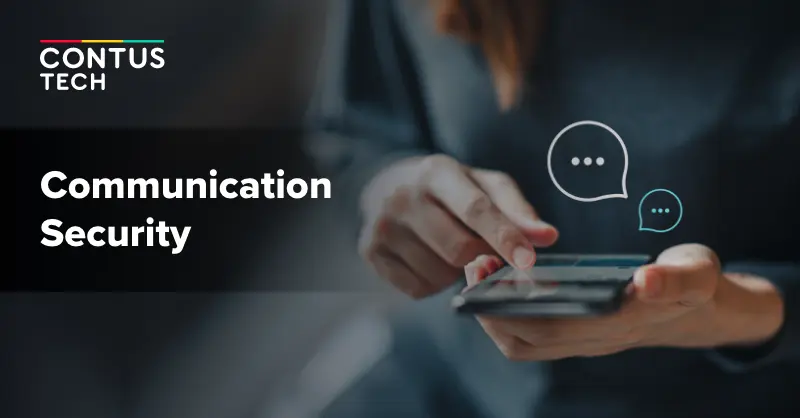How To Enhance Communication Security? Use These Pro Strategies

“Want to keep your personal & business communication secure between you & your pals? Then this blog is for you.”
Did you know that these days the number of cybersecurity zones are more in number than in the last decade? Well yes!
And what made it double? It is all because of the digital kingdom that we are living in, that makes it easy for anyone to snoop in and read our chats, emails, and calls.
Thus posing concerns for data privacy. So to alleviate this stress for you, we’ve come up with 5 strategies to boost communication security. Ready to dive in?
Table of Contents
What is Communication Security?
Communication security, or COMSEC is a technique to protect any form of data transmitted via chat, phone, or emails from malicious attackers or snoopers.
Plus, COMSEC can be classified into four different categories: Physical security, Emission security, Encryption security, and Transmission security.
Any business that wants to safeguard its conversations must pay heed to all the above methodologies.
Why Should You Use Communication Security?
Having tight and hard-to-crack communication security has become an essential parameter in today’s digital life. It is required for the following reasons:
- Safeguarding sensitive personal information and financial details from unauthorized access.
- Preventing data from the risk of tampering or alteration thus losing integrity.
- Securing business communication, trade secrets, and strategies from malicious attackers.
- Shielding defense data from hackers and other malicious attackers.
- Building trust amongst peers and customers to boost engagement and productivity.
- Minimize the risk of reputation damage and any compromised information.
And trust me mates there are more. Thus making it mandatory to implement security solutions or mechanisms into any file, data, or app.
5 Key Communication Strategies to Safeguard Organizations
Securing communications has become a vital aspect for all kinds of businesses. As it not only protects sensitive information from prying eyes but helps maintain trust too in different communication channels.
1. Physical Security
It is the prime responsibility of a network operator to maintain security in physical infrastructure, meaning to protect communication infra from tampering or theft.
Secondly, as most of the data transfer happens over the internet, the next thing to safeguard is the server component.
Even here, the operators need to take extra precautionary measures for smooth connectivity.
So what measures to take?
- Restricting access to server rooms and network facility zones.
- Installing cameras to monitor and record access.
- Keeping hardware cool from outer humid and hot temperatures.
2. Network Security
The parameters that determine network security are planned in the initial stage itself, even before the system software and network topology are designed.
And the reason for such initial security inception is to ensure a smooth flow of data by minimizing unauthorized access.
So what measures to take?
- Adding firewalls to control incoming and outgoing traffic.
- Identify threats and frauds by launching intrusion detection mechanisms.
- Using HTTPS protocol for transmitting data.
- The hardware units should have a regular power supply without a break.
- Networks must be air-gapped, meaning there should be the least possibility for external access.
- Using the best free VPN can also add an extra layer of security by encrypting data traffic and masking IP addresses, especially when remote access is necessary.
3. Preventing Unauthorized Access
This strategy helps to ensure communication security with any data integrity laws, and staying compliant with them.
These days, it has become quite common for people to access sensitive information like usernames, personal details, PINs, and more. Therefore, certain steps have to be taken to prevent unauthorized access:
So what measures to take?
- Implementing multi-factor authentication to enhance secure logins.
- Adding a strong layer of access controls within a communication system.
- Instantly revoking the access of terminated employees.
- Frequently monitoring and updating access credentials.
4. Data Encryption During Transmit
The purpose of this strategy is to secure the data that is transmitted via the Internet as it poses a great risk of tampering or unauthorized access by prying parties.
So what measures to take?
- Data can be encoded using strong encryption protocols like SSL/TLS, and AES.
- Adding a protective coating over the data using E2E encryption standards.
- Securing the cryptographic keys used for transmission.
- Have a check whether the financial data and login IDs are in encrypted format.
5. Admin Controls
This step is required if you are thinking of securing your entire communication system. And to do so, admins need to rightfully manage access controls to employees when they join or leave the company.
This way, businesses can stay compliant with GDPR laws, HIPAA regulations, and similar boards.
So what measures to take?
- Giving the right access to employees based on their roles.
- Identifying security vulnerabilities by conducting regular audits.
- Updating the system regularly whenever a new software patch is released.
Now that you have an idea of which strategies to use, your enterprises can create a defense wall against all attacks. Next, we will see the different platforms that help any business overcome mishaps.
Best Tools for Securing Business Communication
As we said, accidents are prone to happen if security is not placed correctly. And within the world of the internet, even the slightest mishap can cause great damage to a business’s reputation.
Hence, it is required to opt for platforms that offer robust secure communication solutions. Some of them are listed below. Make your choice when selecting.
1. Perception Point
This platform aids businesses in offering extra-layer protection to emails and collaboration services, with its advanced threat detection mechanisms.
Plus, they are equipped with AI learning that helps easily detect any threat and mitigates it right away thus boosting the security of business communications.
2. Malifence
As it goes with the name, Malifence is used to prevent any kind of malicious attacks. It is an email service that offers E2E encryption solutions for emails and documents by using MFA, digital signatures, and more.
Also, they foster private communication at all places thus making it an ideal choice for businesses.
3. Pexip
Pexip is a collaborative platform that is greatly used by military groups for virtual meetings and real-time communication. Precisely, it offers great security for video conferencing solutions.
It achieves this by adding strong encryption protocols and making use of self-hosted APIs to render security.
4. Rocket.chat
Built to provide real-time communications to various industries, this provider is an expert in offering secure messaging platforms with MFA, E2E encryptions, and advanced access control capabilities.
Additionally, its on-premise deployment makes it possible for businesses to take complete control of data and security.
So these were some of the best platforms offering security on communications. And the next section is a cherry on the cake, an API provider that offers A to Z of security features.
MirrorFly- An E2E Encrypted & Secure Enterprise Messaging Solution
MirrorFly is an in-app communication SDK provider of video, voice, and chats that helps developers to build highly secured chat apps across Android, iOS, and the Web.
And to secure communications across platforms, it uses a wide range of encryption strategies to ensure no access is given to sensitive messages.
The proof of its presence is the 1B+ conversations that MirorFly has driven to date with its low-latent, secured, and scalable SDKs. Some of the security protocols it uses include:
- AES-256
- Signal Protocol
- SSL/TLS
- E2E Encryption, MFA
- HIPAA, GDPR Compatibilities
- OMEMO Encryption
- KDF Chain
- X3DH Agreement Protocol and ECDH Key Exchange
Above all these, MirrorFly offers a self-hosted solution to allow businesses to take complete control of security and personalize their solution the way they need by hosting apps on their on-premises.
Finally, because of all these merits, it is highly preferred by businesses from varied verticals like Defense, Logistics, Healthcare, Education, E-commerce, and more.
Wrapping Up!
To conclude, communication security is a very important criterion to implement in any project. And why it is important is what we saw in the blog above.
So, before you head onto your next project or mid-way through your existing one, make sure to implement these strategies. If doing this comes as a tedious task, simply use Mirrorfly’s self-hosted SDKs and see what wonders it makes.
Frequently Asked Questions:
What are the examples of communication security?
Communication security includes the following types – cryptosecurity, emission security, physical security, transmission security, firewalls, digital signatures, MFAs, VPNs, and more.
Why is communication security important?
Communication security or COMSEC is crucial for safeguarding information and protecting user privacy against any types of cyber threats. As most of the communication happens digitally, there is a high risk of data getting intercepted by unauthorized people or malicious actors.
What is secure communication?
Secure communication is a means to protect data transferred between two parties over the internet from any third parties or unauthorized access. Plus, a secure communication system maintains the integrity, authenticity, and confidentiality of information always.
How can MirrorFly help in implementing communication security?
MirrorFly keeps in-app communication between peers secure from any third party access by implementing stringent security measures in its APIs and SDKs like AES-256, SSL/TLS, Signal protocol, OMEMO encryption, KDF chain, E2E encryption mechanisms, and more.
How can organizations ensure effective communication security?
Organizations planning to foster secure communications can opt for self-hosted solutions that give them the flexibility to host data and apps on their own premise servers, & take complete control over security. Additionally, they can have an alarm system or MFA to ensure maximum security.
How can businesses benefit from MirrorFly’s solutions?
MirrorFly’s self-hosted solution gives businesses the flexibility to host their data and chat apps on their own servers, thus letting them take complete control of security. Plus, with its self-hosted SDKs, businesses can avail lifetime ownership of source codes, and brand apps as per their needs, and make required customizations.
Looking To Build Your Own White-label Chat App?
Get our enterprise-grade communication solution, that can be set up on your company servers.
Contact Sales100% customizable
Topic-based Chat
Full source code





Hii,
I’ll definitely be back for more! How can organizations ensure effective communication security?
Sure Shabana, you can visit our blog. Organizations can ensure effective communication security by implementing end-to-end encryption, using secure communication protocols such as HTTPS or TLS, regularly updating software for security patches, enforcing strong authentication measures, and providing employee training on cybersecurity best practices.
Hello guys,
Keep up the fantastic work! could you explain what are some common communication security protocols and technologies?
Yes I can. Common communication security protocols and technologies include Transport Layer Security (TLS), Secure Socket Layer (SSL), Virtual Private Networks (VPNs), Secure Shell (SSH), Pretty Good Privacy (PGP), and end-to-end encryption methods like Signal Protocol. These tools encrypt data during transmission, authenticate parties, and safeguard against eavesdropping, tampering, and unauthorized access.
Great post! I found your insights really thought-provoking. May I know what are the common threats to communication security?
Thank you Sharmi,
Common threats to communication security include eavesdropping, man-in-the-middle attacks, data interception, phishing, malware, spoofing, and denial-of-service (DoS) attacks. These threats aim to intercept, manipulate, or disrupt communication channels, compromising the confidentiality, integrity, and availability of data.
Hello team,
I would like to know why is communication security important? is there anyone to help me?
Communication security is vital to safeguard sensitive information, maintain privacy, prevent unauthorized access, and uphold trust between parties. Without it, data breaches, identity theft, espionage, and financial losses become significant risks in both personal and organizational contexts.
Hi,
This blog so informative, keep posting.. can you explain what is end-to-end encryption (E2EE) and why is it important for communication security?
End-to-end encryption (E2EE) is a method that ensures only the communicating users can read the messages. It encrypts data on the sender’s device and decrypts it only on the recipient’s device. E2EE is crucial for communication security as it prevents intermediaries and eavesdroppers from accessing sensitive information.